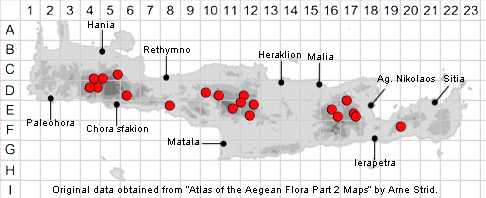SPECIES DESCRIPTION
RANUNCULUS SPRUNERIANUS
Family and Genus:- See-
Common Names:- None
Homotypic Synonyms:- None
Meaning:- Ranunculus (L) Little-frog, diminutive of rana, (reference to the water-
loving habit of many species).
Sprunerianus (L) Possibly for the German cartographer and scholar.
Karl Spruner von Merz (1803 -1892).
General description:- Perennial with a dense cluster of spreading, spindle-shaped
root tubers.
Stem:-
1) 20-40 cm, erect, rather rigid, patent-pilose, usually divaricate in the upper half or
third. Usually leafless up to the first branching.
Leaves:-
1) Basal;
a) petiole, 2-4 times as long as the lamina, sparsely patent-pilose.
b) lamina, sub-orbicular in outline, 2-4 cm broad, cordate at the base, deeply
3-5-partite with rounded incisions, segments fanning out above with short
crenate lobes.
2) Cauline, few and reduced.
Flowers:-
1) (1-)3-10.
2) Sepals, appressed, 8-11 mm, elliptic, pale green, sparsely pilose.
3) Petals, 1.5 times as long as the sepals, broadly obvate, rounded, bright yellow.
4) Receptacle, glabrous.
Fruit:-
1) Achenes;
a) head, 10-16 x 6-9 mm, broadly cylindrical to ellipsoid, squarrose.
b) body, c. 2 mm, compressed, obliquely suborbicular, finally brown at the
centre and usually with short, tubercle-based bristles (occasionally almost
smooth), with a greenish wing confluent with a broad-based, ± hooked beak
1.5-2 mm.
Key features:-
1) Stem, usually divaricatelv branched in the upper half or third.
2) Basal leaves, cordate at the base. 3-lobed to c. 3/4 with rounded incisions and
obovate lobes
3) Head of the achenes, 10-16 x 6-9 mm, broadly cylindrical to ellipsoid, squarrose.
Habitat:- Open patches in scrubland vegetation and dry open shrubby vegetation,
meadows fallow fields, olive groves, dolines in coniferous woodland, often on
shallow soil amongst limestone outcrops, 0-1300( -1900) m
Distribution:- An eastern Mediterranean species occurring in the S and C Balkan
Peninsula, northwards to SW Bulgaria and extending through W and S Anatolia to
W Syria. On Crete confined to the four main massifs, not common.
Flowering time:- March to mid-May or sometimes to mid-June at higher altitudes.
Photos by:- Steve Lenton

